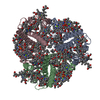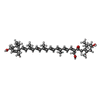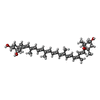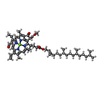+ Open data
Open data
- Basic information
Basic information
| Entry | Database: PDB / ID: 8hlv | ||||||||||||||||||||||||||||||
|---|---|---|---|---|---|---|---|---|---|---|---|---|---|---|---|---|---|---|---|---|---|---|---|---|---|---|---|---|---|---|---|
| Title | Bry-LHCII homotrimer of Bryopsis corticulans | ||||||||||||||||||||||||||||||
 Components Components | Siphonaxanthin chlorophyll a/b binding light-harvesting complex II, Bry-Lhcb1 | ||||||||||||||||||||||||||||||
 Keywords Keywords |  PHOTOSYNTHESIS / light-harvesting complexes / siphonaxanthin / siphonein PHOTOSYNTHESIS / light-harvesting complexes / siphonaxanthin / siphonein | ||||||||||||||||||||||||||||||
| Function / homology | Siphonaxanthin / Siphonein /  CHLOROPHYLL B / CHLOROPHYLL B /  CHLOROPHYLL A / 1,2-DIPALMITOYL-PHOSPHATIDYL-GLYCEROLE / Chem-NEX CHLOROPHYLL A / 1,2-DIPALMITOYL-PHOSPHATIDYL-GLYCEROLE / Chem-NEX Function and homology information Function and homology information | ||||||||||||||||||||||||||||||
| Biological species |  Bryopsis corticulans (plant) Bryopsis corticulans (plant) | ||||||||||||||||||||||||||||||
| Method |  ELECTRON MICROSCOPY / ELECTRON MICROSCOPY /  single particle reconstruction / single particle reconstruction /  cryo EM / Resolution: 2.55 Å cryo EM / Resolution: 2.55 Å | ||||||||||||||||||||||||||||||
 Authors Authors | Li, Z.H. / Shen, J.R. / Wang, W.D. | ||||||||||||||||||||||||||||||
| Funding support |  China, 9items China, 9items
| ||||||||||||||||||||||||||||||
 Citation Citation |  Journal: Structure / Year: 2023 Journal: Structure / Year: 2023Title: Structural and functional properties of different types of siphonous LHCII trimers from an intertidal green alga Bryopsis corticulans. Authors: Zhenhua Li / Cuicui Zhou / Songhao Zhao / Jinyang Zhang / Xueyang Liu / Min Sang / Xiaochun Qin / Yanyan Yang / Guangye Han / Tingyun Kuang / Jian-Ren Shen / Wenda Wang /   Abstract: Light-harvesting complexes of photosystem II (LHCIIs) in green algae and plants are vital antenna apparatus for light harvesting, energy transfer, and photoprotection. Here we determined the ...Light-harvesting complexes of photosystem II (LHCIIs) in green algae and plants are vital antenna apparatus for light harvesting, energy transfer, and photoprotection. Here we determined the structure of a siphonous-type LHCII trimer from the intertidal green alga Bryopsis corticulans by X-ray crystallography and cryo-electron microscopy (cryo-EM), and analyzed its functional properties by spectral analysis. The Bryopsis LHCII (Bry-LHCII) structures in both homotrimeric and heterotrimeric form show that green light-absorbing siphonaxanthin and siphonein occupied the sites of lutein and violaxanthin in plant LHCII, and two extra chlorophylls (Chls) b replaced Chls a. Binding of these pigments expands the blue-green light absorption of B. corticulans in the tidal zone. We observed differences between the Bry-LHCII homotrimer crystal and cryo-EM structures, and also between Bry-LHCII homotrimer and heterotrimer cryo-EM structures. These conformational changes may reflect the flexibility of Bry-LHCII, which may be required to adapt to light fluctuations from tidal rhythms. | ||||||||||||||||||||||||||||||
| History |
|
- Structure visualization
Structure visualization
| Structure viewer | Molecule:  Molmil Molmil Jmol/JSmol Jmol/JSmol |
|---|
- Downloads & links
Downloads & links
- Download
Download
| PDBx/mmCIF format |  8hlv.cif.gz 8hlv.cif.gz | 255.6 KB | Display |  PDBx/mmCIF format PDBx/mmCIF format |
|---|---|---|---|---|
| PDB format |  pdb8hlv.ent.gz pdb8hlv.ent.gz | 202.2 KB | Display |  PDB format PDB format |
| PDBx/mmJSON format |  8hlv.json.gz 8hlv.json.gz | Tree view |  PDBx/mmJSON format PDBx/mmJSON format | |
| Others |  Other downloads Other downloads |
-Validation report
| Arichive directory |  https://data.pdbj.org/pub/pdb/validation_reports/hl/8hlv https://data.pdbj.org/pub/pdb/validation_reports/hl/8hlv ftp://data.pdbj.org/pub/pdb/validation_reports/hl/8hlv ftp://data.pdbj.org/pub/pdb/validation_reports/hl/8hlv | HTTPS FTP |
|---|
-Related structure data
| Related structure data |  34883MC  8hpdC  8hq8C M: map data used to model this data C: citing same article ( |
|---|---|
| Similar structure data | Similarity search - Function & homology  F&H Search F&H Search |
- Links
Links
- Assembly
Assembly
| Deposited unit | 
|
|---|---|
| 1 |
|
- Components
Components
-Protein , 1 types, 3 molecules ABC
| #1: Protein | Mass: 26696.133 Da / Num. of mol.: 3 / Source method: isolated from a natural source / Source: (natural)  Bryopsis corticulans (plant) Bryopsis corticulans (plant) |
|---|
-Non-polymers , 6 types, 57 molecules 










| #2: Chemical | | #3: Chemical | ChemComp-0IE / #4: Chemical | #5: Chemical | ChemComp-CHL /  Chlorophyll b Chlorophyll b#6: Chemical | ChemComp-CLA /  Chlorophyll a Chlorophyll a#7: Chemical |  Phosphatidylglycerol Phosphatidylglycerol |
|---|
-Details
| Has ligand of interest | Y |
|---|
-Experimental details
-Experiment
| Experiment | Method:  ELECTRON MICROSCOPY ELECTRON MICROSCOPY |
|---|---|
| EM experiment | Aggregation state: PARTICLE / 3D reconstruction method:  single particle reconstruction single particle reconstruction |
- Sample preparation
Sample preparation
| Component | Name: Bryopsis corticulans chlorophyll a/b-type light-harvesting complex II homotrimer Type: COMPLEX / Entity ID: #1 / Source: NATURAL |
|---|---|
| Source (natural) | Organism:  Bryopsis corticulans (plant) Bryopsis corticulans (plant) |
| Buffer solution | pH: 7.8 |
| Specimen | Embedding applied: NO / Shadowing applied: NO / Staining applied : NO / Vitrification applied : NO / Vitrification applied : YES : YES |
Vitrification | Cryogen name: ETHANE |
- Electron microscopy imaging
Electron microscopy imaging
| Experimental equipment |  Model: Titan Krios / Image courtesy: FEI Company |
|---|---|
| Microscopy | Model: FEI TITAN KRIOS |
| Electron gun | Electron source : :  FIELD EMISSION GUN / Accelerating voltage: 300 kV / Illumination mode: FLOOD BEAM FIELD EMISSION GUN / Accelerating voltage: 300 kV / Illumination mode: FLOOD BEAM |
| Electron lens | Mode: BRIGHT FIELD Bright-field microscopy / Nominal defocus max: 2000 nm / Nominal defocus min: 1000 nm Bright-field microscopy / Nominal defocus max: 2000 nm / Nominal defocus min: 1000 nm |
| Image recording | Electron dose: 60 e/Å2 / Film or detector model: GATAN K3 BIOQUANTUM (6k x 4k) |
- Processing
Processing
CTF correction | Type: PHASE FLIPPING AND AMPLITUDE CORRECTION | ||||||||||||||||||||||||
|---|---|---|---|---|---|---|---|---|---|---|---|---|---|---|---|---|---|---|---|---|---|---|---|---|---|
3D reconstruction | Resolution: 2.55 Å / Resolution method: FSC 0.143 CUT-OFF / Num. of particles: 614955 / Symmetry type: POINT | ||||||||||||||||||||||||
| Refine LS restraints |
|
 Movie
Movie Controller
Controller




 PDBj
PDBj










